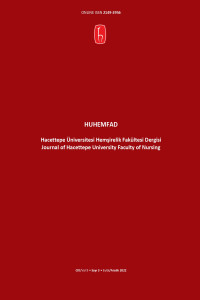Öz
Amaç: Araştırma hemşirelik öğrencilerinin pandemi döneminde, güdülenmelerini ve güdülenme düzeylerini etkileyen faktörleri incelemek amacıyla yürütülmüştür.
Gereç ve Yöntem: Tanımlayıcı tipteki araştırma 2020-2021 akademik yılında, İzmir’de bir hemşirelik fakültesinde eğitimini sürdüren 292 öğrenciyle yürütülmüştür. Tabakalı örnekleme tekniği kullanılmıştır. Veriler Tanıtıcı Bilgi Formu ve Güdülenme Kaynakları ve Sorunları Ölçeği’nden oluşan online anket formu ile elde edilmiştir. Veri analizinde Mann Whitney U ve Kruskal Wallis kullanılmıştır.
Bulgular: Katılımcıların %81.3’ü kadın, %64.7’si 20-22 yaş grubundadır. GKSÖ puan ortalamaları içsel 39.22±5.96, dışsal 18.99±2.53, olumsuz 26.26±5.47 ve toplam güdülenme 84.43±9.48 olarak belirlenmiştir. Öğrencilerin mesleki güdülenmesinin pandemi sürecinde vaktinin çoğunun geçtiği yer, mezuniyet sonrası meslekte çalışma isteği, pandemi sürecinde toplumun mesleğe bakış açısının değiştiğini düşünme, mesleğin gelecek algısı değişkenlerine göre farklılık gösterdiği belirlenmiştir.
Sonuç: Araştırmada öğrencilerin güdülenme düzeyi literatürle benzer ortalamada belirlenmiştir. Mezuniyet sonrasında hemşirelik yapmak istemeyenlerin, mesleğin geleceği hakkında olumsuz düşünenlerin, pandemi döneminde toplum gözünde hemşirelik imajında değişim olmadığını düşünenlerin ve pandemi dönemini çoğunlukla ailesinden uzakta geçirenlerin bu değişkenlerdeki diğer gruplara göre mesleki güdülenmesinin daha düşük olduğu belirlenmiştir.
Anahtar Kelimeler
Motivation nursing pandemics student Hemşirelik motivasyon öğrenciler pandemik
Öz
Aim: The research was carried out to examine the effective factors of the motivation of nursing students during the Covid-19 pandemic.
Material and Methods: The descriptive study was conducted with 292 nursing students studying at a nursing faculty in Izmir in the 2020-2021 academic year. A stratified sampling technique was used. The data were obtained with an online questionnaire consisting of the Introductory Information Form and the Motivation’s Resources and Problems Scale. Mann Whitney U and Kruskal Wallis tests were used in data analysis.
Results: 81.3% of the participants were women, and 64.7% were in the 20-22 age group. The mean scores of the scale were determined as intrinsic 39.22±5.96, extrinsic 18.99±2.53, negative 26.26±5.47 and total motivation 84.43±9.48. It has been determined that the professional motivation of the students differs according to the variables of the place where most of their time is spent during the pandemic process, the desire to work in the profession after graduation, the thinking that society's perspective on the profession has changed during the pandemic process, and the future perception of the profession.
Conclusion: In the study, the motivation level of the students was determined similarly to the literature. It has been determined that those who do not want to work as a nurse after graduation, those who think negatively about the future of the profession, those who think that there is no change in the image of nursing in the eyes of society during the pandemic period, and those who spend the pandemic period mostly away from their families, have lower professional motivation than the other groups in these variables.
Anahtar Kelimeler
Motivation nursing pandemics student Hemşirelik motivasyon öğrenciler pandemik
Ayrıntılar
| Birincil Dil | Türkçe |
|---|---|
| Konular | Sağlık Kurumları Yönetimi |
| Bölüm | Araştırma Makaleleri |
| Yazarlar | |
| Yayımlanma Tarihi | 6 Ocak 2023 |
| Gönderilme Tarihi | 21 Ağustos 2021 |
| Yayımlandığı Sayı | Yıl 2022 Cilt: 9 Sayı: 3 |


